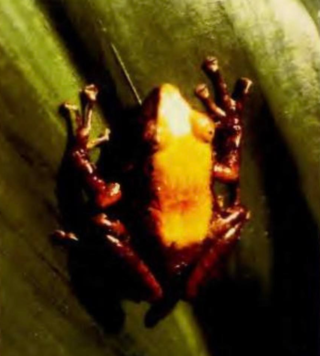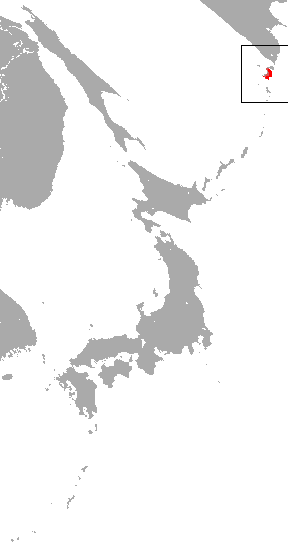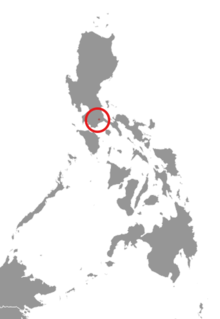
The shrewlike rats, genus Rhynchomys, also known as the tweezer-beaked rats are a group of unusual Old World rats found only on the island of Luzon in the Philippines. They look a great deal like shrews and are an example of convergent evolution. Shrewlike rats evolved to be vermivores (worm-eaters) and insectivores feeding on soft-bodied invertebrates associated with leaf litter.
This article is a list of biological species, subspecies, and evolutionary significant units that are known to have become extinct during the Holocene, the current geologic epoch, ordered by their known or approximate date of disappearance from oldest to most recent.

The Luzon montane forest mouse is a species of rodent in the family Muridae, from the genus Apomys. It occurs only in the Philippines, where it has been found on the large northern island Luzon. It is most closely related to the large Mindoro forest mouse, which occurs on Mindoro. There may be another related species in the Sierra Madre, but this species is yet undescribed. The Luzon montane forest mouse is a relatively large, ground-dwelling rat with a tail that is quite short for its genus.

The Isarog shrew-rat or Mount Isarog shrew-rat is a species of rodent in the family Muridae. It is found only in the Philippines.

The Mount Data shrew-rat is a species of rodent in the family Muridae. It is found only in the Philippines.

The Banahao forest frog is a species of frog in the family Ceratobatrachidae. It is endemic to Luzon, Philippines, where it is only known from Mount Banahaw.

The Paramushir shrew is a species of mammal in the family Soricidae. It is endemic to Russia. Its natural habitat is temperate forests. It is likely named for Paramushir Island, home to several other species of shrew in the genus Sorex.

Portenko's shrew is a species of mammal in the family Soricidae that is endemic to Russia.

The World's 25 Most Endangered Primates is a list of highly endangered primate species selected and published by the International Union for Conservation of Nature (IUCN) Species Survival Commission (SSC) Primate Specialist Group (PSG), the International Primatological Society (IPS), Global Wildlife Conservation (GWC), and Bristol Zoological Society (BZS). The IUCN/SSC PSG worked with Conservation International (CI) to start the list in 2000, but in 2002, during the 19th Congress of the International Primatological Society, primatologists reviewed and debated the list, resulting in the 2002–2004 revision and the endorsement of the IPS. The publication was a joint project between the three conservation organizations until the 2012–2014 list when BZS was added as a publisher. The 2018–2020 list was the first time Conservation International was not among the publishers, replaced instead by GWC. The list has been revised every two years following the biannual Congress of the IPS. Starting with the 2004–2006 report, the title changed to "Primates in Peril: The World's 25 Most Endangered Primates". That same year, the list began to provide information about each species, including their conservation status and the threats they face in the wild. The species text is written in collaboration with experts from the field, with 60 people contributing to the 2006–2008 report and 85 people contributing to the 2008–2010 report. The 2004–2006 and 2006–2008 reports were published in the IUCN/SSC PSG journal Primate Conservation,, since then they have been published as independent publications.

Paucidentomys is a genus of rodents of a type commonly known as shrew-rats which was discovered in 2012 in a remote rainforest on the Indonesian island, Sulawesi. The genus is monotypic, consisting of the species Paucidentomys vermidax, or the edented Sulawesi rat. The Latin name may also be translated to its other common name "few-toothed worm-eating rat", referring to the fact that they have only two teeth and may live exclusively on a diet of earthworms.

The Tapulao shrew-rat is a rodent in the subfamily Murinae. It was described in 2007.
The Labo shrew rat is a species of shrewlike rat in the subfamily Murinae. It was discovered at elevations above 1250 m on Mt. Labo of the Bicol Peninsula of Luzon in the Philippines and described in 2019.
The Mingan shrew rat is a species of shrewlike rat in the subfamily Murinae. It was discovered at elevations above 1450 m on Mt. Mingan of the central Sierra Madre of Luzon in the Philippines and described in 2019.
Danilo S. Balete, also known as Danny Balete, was a Filipino zoologist and biologist. His is known for his work on the Philippines' endemic mammal species. He pursued the question of what determines species diversity. The research by Balete and his team overturned previously held notions that diversity decreased in mountainous regions, showing that harsh environments could generate, rather than suppress, species diversity.










